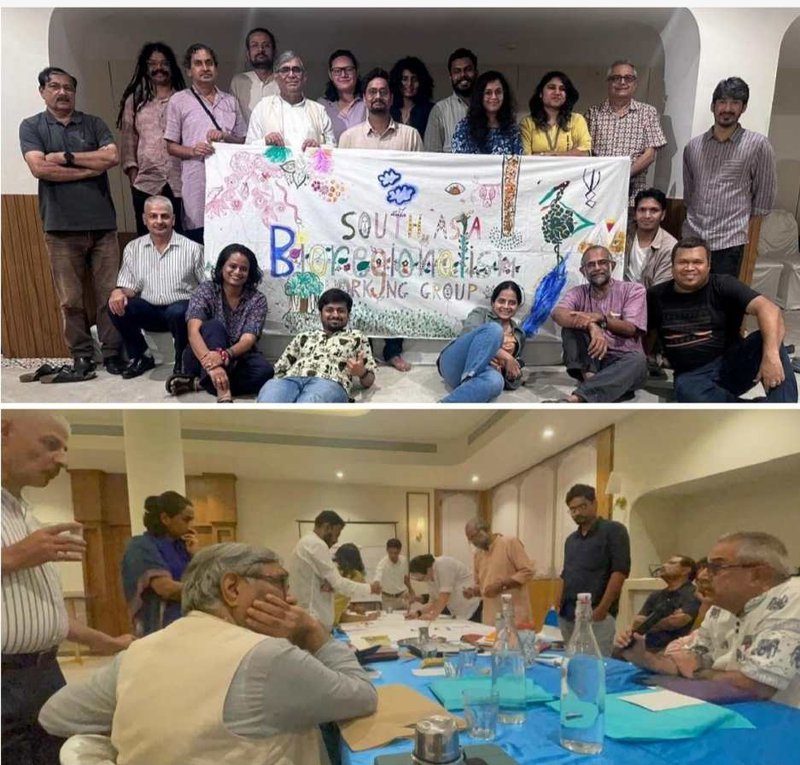As with most activist movements worried about environmental degradation, bioregionalism too rose as a rallying point in the 1970s. Social and environmental activism saw its heyday and stalwarts in the 1980s and 1990s. Unfortunately, its history and effectiveness in the first quarter of the 21st Century has been insipid and disappointing. NGOs in the Global North have been tamed and domesticated to serve official procedural fetishism of SDGs, MDGs and COP platitudes, while their cousins in the Global South are political orphans, having been vilified and marginalized as ”anti-developmentalists”. In this historical desert, in early September this year, a brave group of old and young environmentalists gathered in Bhopal, Madhya Pradesh, India to share their angst and to see if a new path forward could be forged.

How did this sad state of affairs arise even as global environmental degradation has gotten worse? Why has it not galvanized the younger generation (more of whose future is at stake than those of the oldies) to reverse the decline and come forth with more robust activism that would make a difference? I will speculate about that at the end of this essay, but first some background about the bioregionalism movement.
Political boundaries of nation-states are determined by military history and administrative boundaries therein by convenience of transport and communication. The logic of such boundary definitions often go against nature. Rivers as boundaries – a natural conclusion when armies of both sides find it easier to defend themselves – makes it near impossible to plan or execute irrigation, flood control or other projects in the riparian lands. River basin as a unit of planning or administration makes much sense, mostly to hydrologists but not for the powers-that-be. The same applies to movements of wildlife, rainfall, information and even people when the nation-state container is assumed to contain ALL social, economic and other activities, every other flow being “foreign”.
This has prompted a long history of efforts to find more integrative approaches such as Integrated Water Resources Management (IWRM) and today its new avatar, the nexus, with mixed results. Bioregionalism is an effort by those worried about alarming environmental degradation brought about by human activity to find an alternative path ahead that, unlike conventional environmentalism which is mostly a protest AGAINST current state of affairs, is also FOR something else. This tactic very much matches Global South views where being against something merely leads to being branded as against unquestioned hallowed development itself and thus politically suicidal.
I remember our own history in Nepal. When I was in Berkeley as a Fulbright student in the mid-1980s, I had the good fortune to be a “founding observer” of the International Rivers Network. My problem was that, as a Southern environmentalist intent on returning to Nepal after my studies, I could not accept the Northern NGO slogan of No Dams! I argued (unsuccessfully) for No Bad Dams! It was because, as a then government engineer with the Ministry of Water Resources, the former would have me hooted out in no time, while the latter slogan would remove the binary for-against straitjacket and allow space for debate and possibly improved change. It did: the anti-Arun-3 campaign that ensued allowed activists to successfully argue that the World Bank’s proposal to develop the project at roughly five times the market cost was bad economics, that alternatives would give a third more electricity at half the cost and half the time. Ultimately, the campaign managed to see the alternative come to fruition.
The biggest attraction of bioregionalism is its giving co-space to human practices that have co-evolved with the local environment and its constraints to find a more sane lifestyle that differs from the suicidal infinite extractive consumption culture that currently dominates in the name of “progress” and monochrome “development”. It begins by accepting unique ecology and cultural attributes of bioregions and proposes re-inhabitation, meaning giving value to that unique space, enriching it not just physically but also culturally, and not seeing it as merely an exchangeable resource to be exploited and left. It means giving value to food that is grown locally appropriate to the hydroclimatic and ecological conditions of the area; using local materials as far as possible in construction and interior décor; using production and services of local people to the maximum and not rendering them jobless migrants having to fulfil labour requirements elsewhere; and most importantly it means giving primacy to socio-environmental stewardship or custodianship, not exploitative ownership.
All this requires a radical rethinking of governance, indeed representative democracy and the very notion of development itself as well. It is a tall order which the Bhopal Satsang wrestled with it in the South Asian context. In contrast with reductionist analytical approaches, synthesizing holistic ones often get overwhelmed with the plethora of cases and details, in the process missing the forest for the trees. Challenges to bioregionalism in South Asia, as indeed anywhere in the world, are enmeshed with many genuine concerns. First is that the movement is still India-centric and has not engaged enough with its South Asian neighbours. South Asia as a continent in itself has many bioregions that overlap between countries: coastal zones, deserts, islands, riverine deltas, mountains, flood plains and so on. An Indian can spend a lifetime in India itself with any one of these bioregions. However, the advantages of engaging across the border is manifold, especially in local knowledges and institutional practices that not only can benefit neighbours but also India itself as it frees itself from its colonial extractive legacy. Nepal for instance has formalized local community management of resources (forests, drinking water, electricity etc.) that is but a dream in India (as late water secretary Ramaswamy Iyer remarked to me!).
For bioregionalism to succeed in making any headway in South Asia, education must be de-Macaulay-ized to give space to traditional and local knowledge more in tune with bioregional concerns. Democracy that has been hijacked by rapacious business interests must give way to Gandhian Gram Swaraj and traditional decentralized governance structures. Urban built environment that is not only expanding uncontrollably but is also rapaciously and unsustainably colonizing surrounding resources must be re-engineered as Cities as a Force for Good (and not for Bad! CFGs including Desakota regions of neither urban nor rural spaces.). These concepts must find expression in local languages, including people’s understanding of issues such as climate change and biodiversity loss and what it means for their future.
In doing all of these things, if bioregionalism is to find traction and support in mass politics, they have to address immediate fundamental concerns and how they help solve them, concerns such as the inexorable damage from climate change and biodiversity loss that is leading to greater immiseration of the already poor. It is not an easy task because it entails conceptual and political battles with the entrenched forces of extractive capitalism that externalizes much of the costs to the poor and the environment (and internalizes profits within a narrow circle of 1% elites). It must address that fundamental political-economic problem posed by Karl Polanyi: should not markets serve society instead of what prevails currently of societies serving markets? Should finance capital (and concomitant unlimited GDP growth) enjoy unquestioned divine rights of usury even at the expense of societal equity? Should development (“bikas”) be unquestioningly worshipped even when it is mal-development and not apt-development (“ku-bikas and not “su-bikas”) in much of actual practice today?
It is not a question of whether it can be done: it has to be done if humanity and much of life on earth is not to be extinguished. The question is how? First and foremost, new alliances have to be forged among like-minded and concerned folks, who certainly won’t be in full agreement but maybe only in 20 or 30% of the broader concerns. It will require new activism’s networking skills across the region’s myriad overlaps. It will also require a new philosophical approach to governance that values localization of production and consumption over globalized but fragile (as Covid and other conflicts have shown) value chains. In this, the idea of water and energy footprints and their reduction will have to play a key role in future environmental activism.
A very small beginning was made in Bhopal, a first step in a journey of a thousand kilometers. Which is why the word “satsang” was chosen in the title: it is a religious word (“gathering of truth seeking collegium”) hijacked for common civic ends. The small gathering Bhopal was just such a meeting of “sat” seeking individuals that just need to expand their network and joint activism programs for the greater global good.
{Those wanting to know more about South Asia Bioregionalism Working Group or interested to team up for networking can learn more from: https://vikalpsangam.org/south-asia-bioregionalism-working-group/ as well as: https://kalpavriksh.org/wp-content/uploads/2022/04/Nation-states-are-destroying-the-world.-Could-bioregions-be-the-answer_-_-openDemocracy.pdf and: https://in.boell.org/sites/default/files/2022-08/uncovering-pre-district-bioregions-of-i-n-d-i-a-south-asia-bioregionalism-working-group-.pdf }

Dipak Gyawali
Gyawali is Pragya (Academician) of the Nepal Academy of Science and Technology (NAST) and former minister of water resources.
- Navigating An Uncharted, Unravelling World Order
- Jun 19, 2025
- Overcoming Indo-Pak Conflict The Dara Shikoh Way
- May 13, 2025
- Re-Thinking Democracy: Why South Asians Are worried
- Mar 17, 2025
- Nepal’s Governance Mired In Endemic Corruption
- Feb 20, 2025
- What Might The Age Of Trump Look Like?
- Jan 22, 2025












